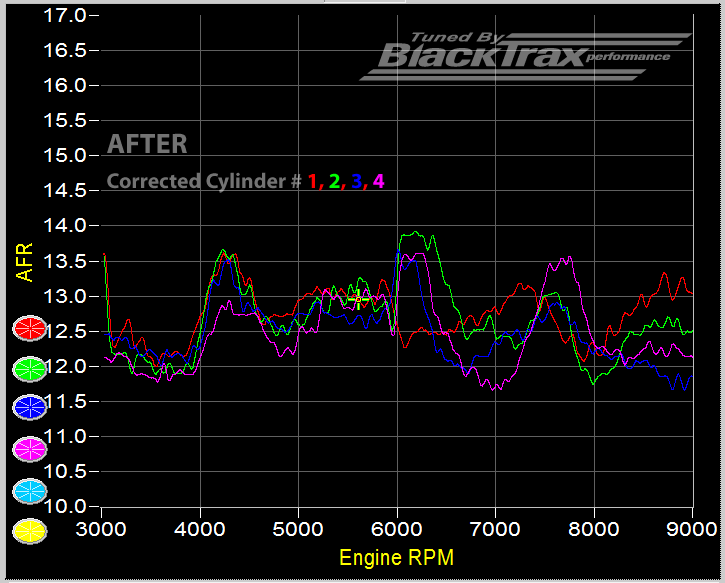Engine: Honda B16A 1.6L Inline 4 Dual Overhead Cam (DOHC) VTEC Engine
EMS: Hondata S300
Hondata's SManager Cylinder Fuel Trim (CFT) parameter gives you the option to add or remove fuel by a percentage to each cylinder over the entire rpm range. Other more elaborate management systems may offer more resolution using a speed density map (rpm vs. load). CFT controls will vary between EMS systems.
A key element in tuning is information provided by data-logging. In this example we've welded 4 Oxygen Sensor (O2) bungs into each primary header tube for individual lambda air/fuel reading. Exhaust Gas Temp (EGT) sensors can also be a useful tuning tool in conjunction with O2's.

All tests were performed on the same engine under the same conditions. In the animated GIF below, note the air fuel ratios (AFR's) before and after CFT adjustment using S300. Each line color represents an individual cylinder. The animation below is a good way to display the BEFORE, "spread out" vs. the AFTER, "tightened up" dyno plot.
Let's take a point, say 5500 rpm. Locate the AFR's for each and average. Roughly we'll use:
Cyl #1 = 13.5:1 (means 13.5 part of air to 1 part of fuel)
Cyl #2 = 13.0:1
Cyl #3 = 12.25:1
Cyl #4 = 13.0:1
Total = 51.75/ 4 cyliners = 12.94:1 AVERAGE AFR @ 5500 rpm
When measuring at the header collector, where all four runners meet to a single pipe, 13.0:1 was what was logged when originally tuned. Only half of the cylinders were actually getting the AFR's we were targeting. Using CFT, we increased a percentage of fuel in Cyl #1 and decreased in Cyl #2. As you can see the results after CFT @ 5500 rpm now have a much lower delta or variation. Corrections yielded about a +4hp and +3tq gain @ 5500 rpm. Although we weren't able to fine tune at every rpm (could have used more adjustability between 6k and 9k rpm), we did the best we could given the software tools provided. Narrowing the AFR gap at 8500 rpm yielded about +6hp and +4tq over baseline.
In these power graphs, the red dotted line represents the baseline. You can see as each dotted line changes color, for the most part power is increasing. This is because each cylinder was getting touched up as we performed the pulls. The solid lines represent the last 4 pulls using CFT, ending with the purple line resulting in the best run and the final run.
Some Things to Consider Before You Start CFT:
All tests were performed on the same engine under the same conditions. In the animated GIF below, note the air fuel ratios (AFR's) before and after CFT adjustment using S300. Each line color represents an individual cylinder. The animation below is a good way to display the BEFORE, "spread out" vs. the AFTER, "tightened up" dyno plot.
Let's take a point, say 5500 rpm. Locate the AFR's for each and average. Roughly we'll use:
Cyl #1 = 13.5:1 (means 13.5 part of air to 1 part of fuel)
Cyl #2 = 13.0:1
Cyl #3 = 12.25:1
Cyl #4 = 13.0:1
Total = 51.75/ 4 cyliners = 12.94:1 AVERAGE AFR @ 5500 rpm
When measuring at the header collector, where all four runners meet to a single pipe, 13.0:1 was what was logged when originally tuned. Only half of the cylinders were actually getting the AFR's we were targeting. Using CFT, we increased a percentage of fuel in Cyl #1 and decreased in Cyl #2. As you can see the results after CFT @ 5500 rpm now have a much lower delta or variation. Corrections yielded about a +4hp and +3tq gain @ 5500 rpm. Although we weren't able to fine tune at every rpm (could have used more adjustability between 6k and 9k rpm), we did the best we could given the software tools provided. Narrowing the AFR gap at 8500 rpm yielded about +6hp and +4tq over baseline.
In these power graphs, the red dotted line represents the baseline. You can see as each dotted line changes color, for the most part power is increasing. This is because each cylinder was getting touched up as we performed the pulls. The solid lines represent the last 4 pulls using CFT, ending with the purple line resulting in the best run and the final run.
1) CLEAN INJECTORS:
If you've got a lot of miles on your injectors, don't expect them to be balanced and flow properly. Purchase new injectors from distributors who offer flow test datasheets or send your existing injectors out for cleaning/balancing and request datasheets.
2) EXHAUST LEAKS:
Leaks will throw off readings. Change gaskets or repair cracks prior to tuning
3) WELDING:
Are you ok with having us welding 4 bungs on your header?
4) O2'S IN STOCK:
Depending on who's tuning, do you or we have enough wideband O2's? It would be a good idea to have these details figured out before your dyno.
5) FINE TUNING:
This procedure involves labor in header removal, fabrication and tuning time. Make sure you are prepared spend time and money for longevity, reliability and repeatable performance = repeatable lap times. Consider saving costs by removing the header yourself and bringing it to us for welding. Then bring it back for the tune once you've put the header back on the car.
Costs vary per application. BT Dynotuning is by appointment only. For individual fuel tuning inquiries please Contact BT.





